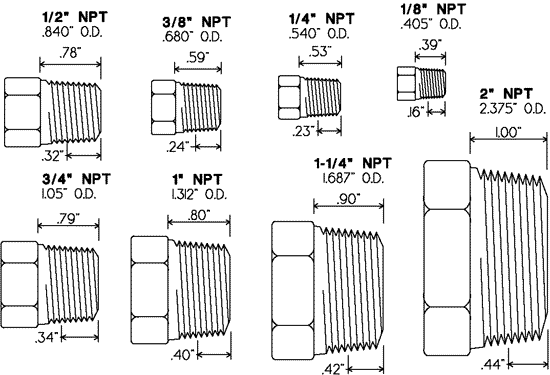Related Resources: hardware
Pipe Thread Installation Torque Table Chart
Fluids, Piping and Hydraulic Design Data
Brass and steel Pipe thread (NPT) installation procedure and torque specification table and chart.
T.F.F.T = Assembly turns from finger tight with pipe thread sealant or teflon tape applied.
| Pipe Thread Size NPTF |
T.F.F.T. |
| 1/8 - 27 | 2 - 3 |
| 1/4 - 18 | 2 - 3 |
| 3/8 - 18 | 2 - 3 |
| 1/2 -14 | 2 - 3 |
| 3/4 - 14 | 2 - 3 |
| 1 - 11 1/2 | |
| 1 - 11 1/4 | 1.5 - 2.5 |
| 1 - 11 1/2 | 1.5 - 2.5 |
| 2 - 11 1/2 | 1.5 - 2.5 |
Torque
| Size | in-lbs | Newtons-m |
| 1/16" | 5.0 | 0.57 |
| 1/8" | 7.0 | 0.79 |
| 1/4" | 16 | 1.81 |
| 3/8" | 23 | 2.60 |
| 1/2" | 30 | 3.39 |
| 3/4" | 54 | 6.10 |
| 1" | 78 | 8.81 |

Pipe threads are not a bare metal to metal sealing thread there should be pipe tape or thread sealer applied to the threads to make a low pressure seal. Metal to plastic sometimes gets a seal exclusively by torque but still pipe tape or sealer is the recommended practice.
Pipe threads on plastics pipes and other parts used in plastics plumbing and pneumatic assemblies require only hand tight assembly to effect a good seat, especially if a compatible sealant tape or compound is used. Assembling a tapered male pipe thread into a mating female thread part is analogous to driving a cone into a round hole and may result in a split boss. Sometimes straight threads and an O-ring seal can avoid the need for pipe threads. When pipe threads must be used, torque control is essential. When mating metal to plastics pipe threads, the threaded plastics component should be the male member, so that the plastics are in compression.
If torque can be controlled during assembly, fluoroplastics tape should be used on female plastics pipe threads. If torque cannot be controlled, an external hoop ring, either pressed on or molded in, should be considered. Flats should not be designed into plastics parts for assembly purposes because they will encourage overtightening. If some provision for improved gripping must be made, wings or a textured surface may be used. An approximate formula for the hoop stress σ produced in a plastics boss with internal pipe threads is
Pipe Thread Hoop Stress under Torque
Eq. 1
σ = ( 3 · T ) / ( t · d · L)
Equation 1 assumes certain geometric relationships and a coefficient of friction of 0.15. If compatible thread lubricants are used during assembly, the torque must be reduced. To ensure safety and reliability, all threaded assemblies must be subjected to long-term testing under operating pressures, temperatures, and stresses caused by installation procedures exceeding those likely to be encountered in service.
Where
σ = hoop stress, lbs/in2, (N/m2)
T = Torque, in-lbs, (N-m)
t = wall thickness, in, (m)
d = Pipe outside diameter in, (m)
L = length of thread engagement in, (m)
Example calculation:
T = 5 in-lbs
t = 0.05 in
d = 0.125 in
L = 0.5 in < - which is very generous for 1/8” pipe thread
Stress = ( 3 * 5 in-lbs) / ( 0.125 in * 0.05 in * 0.5 in )
Stress = 4,800 lbs/in2 or psi
Reference:
Machinery's Handbook, 29th Edition, Page 578
Related:
- Torque Conversion Calculator
- Pipe Size Schedule Chart
- External British Pipe Threads (Whitworth Form) Table per. BS EN ISO 228
- Pipe Thread Pitch Diameter Formulas and Calculator
- Pipe Thread Installation Torque Table Chart
- Internal Dryseal Pipe Thread Tap Drill Sizes Recommendations
- National Standard Taper Pipe Threads NPT Chart
- Fluid Flow Engineering and Design Resoures
- External Pipe Thread Design, Specifications and NPT Pipe Thread Tolerances
- Straight Pipe Threads Table Chart ANSI
- National Standard Taper Pipe Threads Size NPT Chart
- Standard Taper Pipe Threads NPT Basic Dimensions, American National Standard